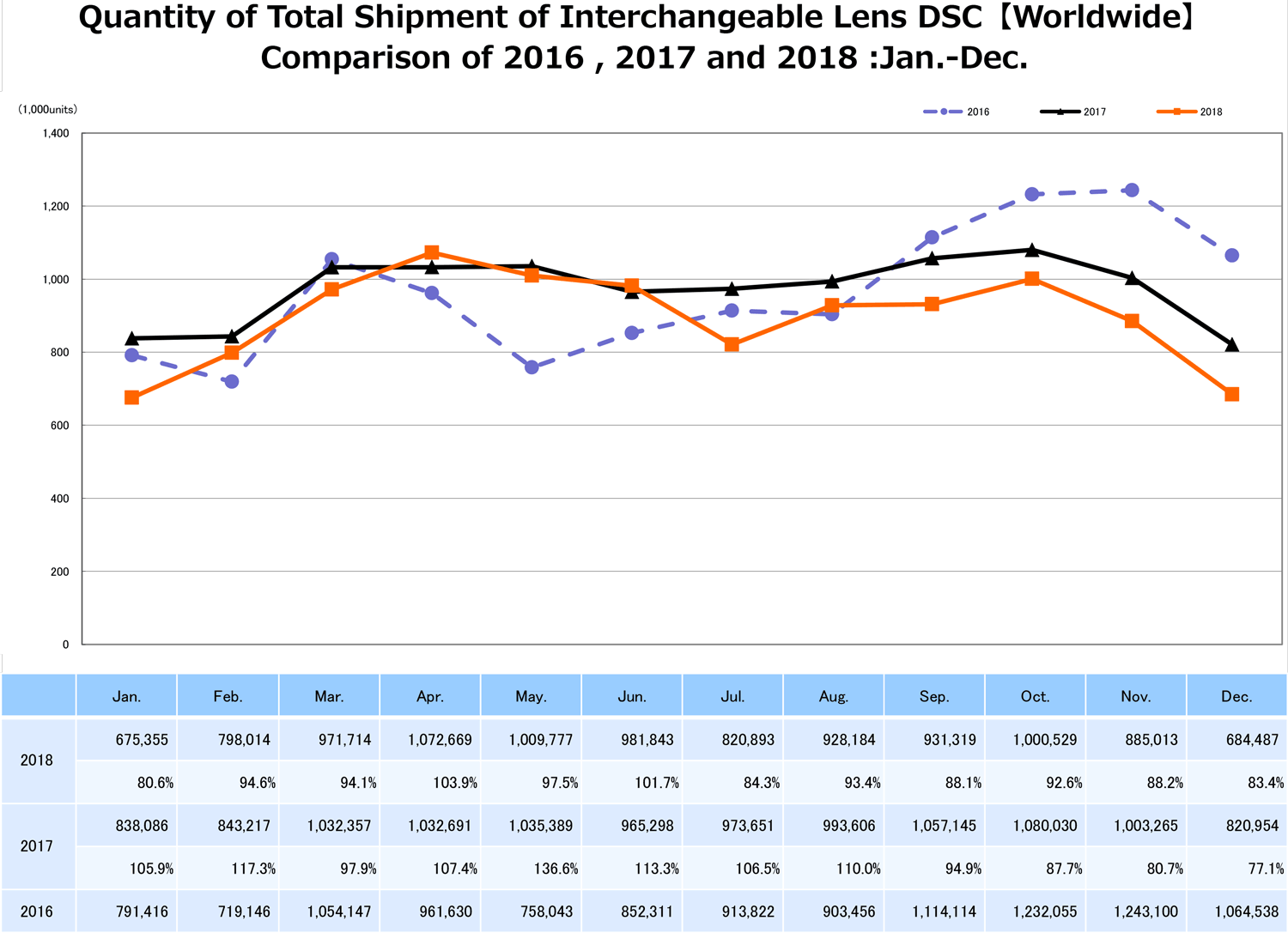The full years’ production and shipment figures for 2018 were released by the Japanese Camera & Imaging Products Association (CIPA) this week, along with its annual report on the market and predictions for 2019, which we will re-publish below.

The above graph on interchangeable lens camera shipments December data from CIPA: While the market for interchangeable lens cameras and lenses is down, it’s been the digital compact market which has suffered most, although the carnage of the last five years seems to be levelling off. Holding up the interchangeables market is the mirrorless segment, which according to more detailed CIPA figures, in fact increased year-on-year sales compared to 2017 by 1.4 percent in volume and 23 percent in value.
So while compacts are falling way behind, DSLRs are falling behind as well, which has resonances with that old joke about the two hikers being pursued by a bear. DSLR’s still outsell mirrrorless cameras by 6.62 million to 4.14 million, but in dollars terms, the value of the two segments is about equal.
Last year was one of the least exciting on record in terms of new camera technology, and on the other hand 2019 is shaping up as one of the more exciting, with Nikon already releasing two mirorrless cameras to great reviews; Canon another, and with a relatively inexpensive model apparently not far off; Olympus releasing its most professional camera to date in the EM-1X; while Fujifilm shrunk the medium format, um, format with the GFX-50R. This week Panasonic showed its two entrants to the full-frame mirrorless market, the Lumix S1R and S1. Lens manufacturers continue to push out new models to cover all the new mounts coming onto the market. And we are barely out of January.
It’s a bit of a cliche that the photographic market thrives on innovation and if it’s true, and if 2018 was a dud year because there wasn’t much new out there worth spending money on, the camera makers and sellers and their customers might experience a more positive year than CIPA is tipping!
– Inside Imaging
CIPA REPORT

Total shipments of digital cameras in 2018 (the cumulative total of shipments from January to December) fell by 22.2 percent year on year to 19,423,371 units (represented by units of one million in the attached table).
After continued growth of the market since 1999, the year our statistics started, shipments fell for the first time in 2009 due to the global recession. They fell again in 2011 because of the serious impact on production from the Great East Japan Earthquake and flooding in Thailand. Since then, shipments have continued to decline, and though an increase was observed in 2017, the year 2018
saw another decline.
Total shipments of digital cameras fell more than 20 percent from the level a year before with a significant decline of 34.9 percent in built-in lens digital cameras to 8.7 million units. They still account for more than 40 percent of the total shipments even after the position of key product was taken over by interchangeable lens digital cameras, which include single-lens reflex and mirrorless cameras, products with higher value added and unit prices.
Indeed, some high-value added models are found among built-in lens digital cameras. However, this category of products has less to offer consumers as a distinct advantage over smartphones than interchangeable lens digital cameras, which, with diverse types of lens available for them, allow users dramatically broad possibilities of expression. In consequence, built-in lens digital cameras were put on the defensive against smartphones.
Shipments of interchangeable lens digital cameras decreased 7.8 percent year on year to 10.8 million units. Those of interchangeable lenses also fell 6.2 percent to 18.0 million units.
The interchangeable lens digital camera is the one and only choice for photographers aspiring to master the art ultimately, as it allows them to choose the best from a variety of lenses for any specific scene or subject. With the explosively rapid spread of smartphones, virtually everyone in the world carries a smartphone. These devices provide many users with an opportunity to discover the joy of taking photos. Once fascinated with photography, they will become interested in realizing greater photographic expression by moving on to digital cameras to take pictures that they could not with a smartphone. Absorbing this ‘step-up demand’, as it is often called, the interchangeable lens digital camera managed to avoid a significant drop in shipments, though failing to secure the same level as the year before.
At the same time, many existing users of interchangeable lens digital cameras, aspiring to master the art of photography, hope to upgrade their camera systems. Their continued high motivation serves as the driving force for the camera industry. The number of interchangeable lenses shipped for every camera stayed at a high level, a factor of 1.6 to 1.7. This demonstrates that many users are tirelessly pursuing a mastery of photography.
Among interchangeable lens digital cameras, the mirrorless camera has made a remarkable leap forward. Its rapid growth may come from a stream of additional purchases, rather than replacement purchases.
Camera makers are working harder to develop products. This enables digital camera users owning more than one camera type, to include both single-lens reflex and mirrorless types, to dynamically expand their camera systems and pick out the best combination of cameras and lenses when taking photos in a specific scene. We expect to see some synergy generated between these two categories with distinctive features.
Total shipments of digital cameras to regions outside of Japan decreased 22.7 percent. As for shipments of digital cameras with built-in lenses, those to regions outside of Japan decreased by 37.5 percent. As for shipments of digital cameras with interchangeable lenses, those to regions outside of Japan decreased by 7.2 percent.
As for shipments of interchangeable lenses, those to regions outside of Japan decreased by 5.4 percent.
There is an increased trend in shipments to regions outside of Japan on a long-term basis. However, differences appeared between the categories in 2018. As for year-on-year changes from the previous year in shipments of interchangeable lens digital cameras, those to regions outside stayed at a higher level than those to Japan. The same is found in shipments of interchangeable lenses.
2019 Outlook
Total shipments (the cumulative total of shipments from January to December) of digital cameras in 2019 are projected to be 16.9 million units, a year-on-year decline of 12.9 percent. Of those, shipments to regions outside of Japan are projected to be 14.4 million units (a year-on-year decline of 13.3 percent).
Broken down by product type, shipments of built-in lens digital cameras are projected to be 6.9 million units (a year-on-year fall of 20.7 percent). Of those, shipments to those regions outside of Japan are projected to be 5.4 million units (a year-on-year decline of 21.7 percent).
Shipments of interchangeable lens digital cameras are projected to be 10.0 million units (a year-on-year fall of 7.4 percent). Of those, shipments to regions outside of Japan are projected to be 9.0 million units (a year-on-year decrease of 7.2 percent).
Shipments of interchangeable lenses are projected to fall 8.3 percent year on year to 16.5 million units. Of those, shipments to regions outside of Japan are projected to decline 8.1 percent year on year to 14.7 million units.
As in 2018, decreased shipments of built-in lens digital cameras will significantly weigh on total shipments of digital cameras. In contrast, shipments of interchangeable lens digital cameras will stay above 90 percent of the level a year before. So will shipments of interchangeable lenses. Against shipments of interchangeable lens digital cameras (bodies), those of interchangeable lenses, the other main actor, are projected to be larger by a factor of 1.6 to 1.7
– CIPA (Camera & Imaging Products Association)





Be First to Comment